|
Chad Dorland was the TrophyCatch Hall of Fame Champion with his 14 lbs. 1 oz. Orange Lake catch. Multiple conservation partners help incentive the citizen-science program with a variety of prizing.
TrophyCatch Season 11 wrapped up this past quarter with a splash as the season festivities finished with the program's two signature annual events, starting with the Hall of Fame Ceremony held at partner Bass Pro Shops' Daytona location. Eleven anglers who caught Hall of Fame bass weighing 13 pounds or more celebrated at the event and received a free Gray Taxidermy mount representing their giant catch. Chad Dorland was crowned as Hall of Fame Champion for the heaviest approved catch of the season, a 14-pound, 1-ounce bass from Orange Lake.
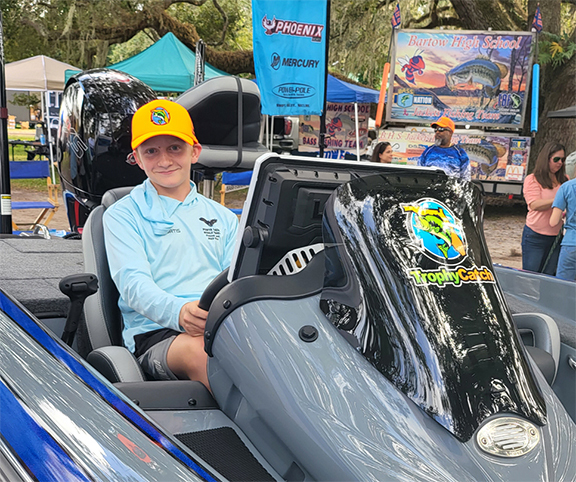 Phoenix boat winner, Curtis, enjoys a practice sit in the driver’s seat as the winner at the final boat drawing event. The Phoenix Boats package is powered by Mercury Marine, guided by Lowrance and anchored by Power-Pole Total Boat Control.
The second event was the Phoenix Boats bass boat drawing held at the Bobby Lane High School Cup at Camp Mack Guy Harvey Lodge, Marina, and RV Resort. Five finalists selected from TrophyCatch registrants faced off in a reverse drawing that left youth angler Curtis Collins the winner of the boat package. While each approved TrophyCatch bass submission greatly increases a participant's chances of being a random drawing finalist, every registrant has a chance to win and this was the case with Curtis who has not submitted any TrophyCatch bass — yet! However, Curtis has been wanting a boat for some time and just recently obtained his boating certificate — and then serendipitously was notified that he was a TrophyCatch boat drawing finalist the very next day! Anglers can register for TrophyCatch to be included in next year's boat drawing (existing registrants are automatically included every year).
Tracy Joseph caught this 8 lbs. 11 oz. beauty in an unnamed Volusia County lake.
Meanwhile, Season 12 is well underway and Florida's very best bass fishing is just around the corner. This quarter has an excellent chance of producing the season's largest bass, and we wish our participants good luck and tight lines in the months ahead. Current stats for TrophyCatch as we enter the new year are:
- 11,569 Lunker Club (8-9.9 lbs.)
- 2,908 Trophy Club (10-12.9 lbs.)
- 143 Hall of Fame (13+ lbs.)
- 14,620 TOTAL approved submissions to date
Register for TrophyCatch or view approved angler catches to help plan your next trip at TrophyCatch.com. Follow TrophyCatch Facebook for featured fish, and FishReelFlorida Instagram for freshwater fishing information and news.
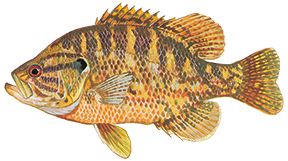
Size: The state record is 2.44 pounds. Most individuals will average close to a quarter pound. The Big Catch minimum qualifying sizes are 0.5 pounds or 9 inches for adults, and 0.4 pounds or 7 inches for youth (see BigCatchFlorida.com).
Appearance: Look for the unique, dark stripes on the cheek radiating back from the red eye. Also note the proportionally large mouth when compared with other sunfishes. The warmouth may occasionally have a tinge of red on the edge of the operculum, suggesting a redear sunfish. However, the much larger redear lacks the distinctive cheek markings.
Range & Habitat: Warmouth are common throughout Florida. While there aren't any sites that are famous for their warmouth fishing, any shallow lake, swamp, marsh or slow-moving stream or canal is a likely spot. They stay around aquatic vegetation, stumps and snags and under the banks of streams and ponds. They have more tolerance for muddy water than most species.
Sporting Quality: This diminutive species has similar habits when compared to the more popular bluegill and redear sunfish and is often caught on the same lures and baits (live worms, crickets, grass shrimp, jigs, spinners and beetle spins). The comparatively larger mouth allows the warmouth to eat bigger prey items, so this fish goes after small minnows or tiny crankbaits more commonly than other bream species. Although the warmouth is usually caught incidentally while fishing for larger species, it puts up a good fight on ultralight tackle and good-sized individuals will often find a place in the panfish angler’s creel.
Fish illustration by Duane Raver, Jr.
|
 |
Florida is loaded with small waters that are ideal for small boats! Not only are small craft incredibly versatile, but they can also put an angler where a bass boat or shore angler just can't go.
Most anglers have noticed that fishing access seems to be getting harder to find due to a variety of factors. The childhood swimming hole is now a shopping mall. The FWC is working hard to buck that trend by preserving existing access sites while at the same time opening up new opportunities. However, many smaller waters simply never had a ramp at all. Or maybe the budget won’t allow for a boat and trailer. You might have the money, but not the parking space. Despite this, anglers can help to broaden their fishing horizons by—thinking small!
Small boats, that is. Which we’ll define, for the purposes of this article, as boats that can be car-topped or stowed in a trunk or pickup bed, and launched by hand. For an average adult, the maximum manageable weight will be around 70 pounds or less, depending on the individual (and check with your doctor first!). All the situations mentioned are where smaller craft can really shine. Below are the most common types, their pros and cons, and accessories to consider.
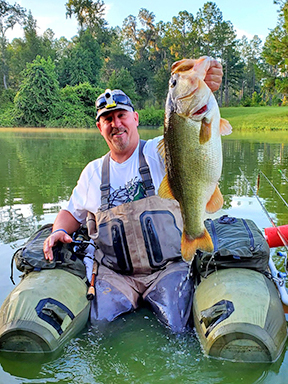
Float tubes
Float tubes are the relative newcomers on the small-craft scene, and in Florida should be fished from . . . very cautiously! The first thing to be said here is to pick a site where you don’t see any alligators, and then remain constantly vigilant—though you’ll want to exercise some extra caution with all the small craft mentioned here, and familiarize yourself with recommended safety precautions at FWC’s Living with Alligators and Crocodiles website. A float tube is basically an inner tube with a seat harness. More advanced designs are more streamlined, some even resembling miniature Zodiac-style inflatable boats. Room for gear is obviously limited, with onboard pouches for holding a couple smaller tackle packs or other gear. Accessories to consider include small fins for maneuvering, and a strap-on rod holder. The primary advantage of the float tube is that it’s the smallest type of boat around—only one step removed from swimming—and can require almost no storage space. The disadvantages include your low profile (definitely not a craft for motorboat waters), slow movement speed . . . and alligators. Prices start at about $80.
Photo: TrophyCatch participant Cliff Willis proves that you can catch big fish with a float tube with this 12 lbs. 4 oz. bass!
|
Inflatables
“Rubber rafts” have been around for a while on the modern boating scene. They’re the lightest craft you can actually sit in, and only require deflating before tossing back in the trunk. If you’re going to purchase one for fishing, go with one of the models designed for that purpose. They’ll usually be more maneuverable than your standard “life raft” inflatable, and often incorporate rod holders and other angler-friendly features. Even more expensive models can incorporate swivel seats and a removable transom for mounting a small motor. There are also inflatable canoes and kayaks, which we’ll keep here in the “inflatables” category. These are more maneuverable and faster than standard inflatable boats, but less stable and more expensive. If you go with an inflatable boat, an electric air pump is an absolute must. Make sure it will plug into a cigarette lighter or has 12-volt battery clips. A foot pump works and is better than huffing and puffing, but will still wear you out, especially with a bigger boat. An emergency patch kit is another accessory to keep on board. Expect to start at around $100 for an inflatable boat, or $200 to $300+ for fishing-specific, canoe, or kayak models. Inflatables that can mount a transom or swivel seats will start at around $500.
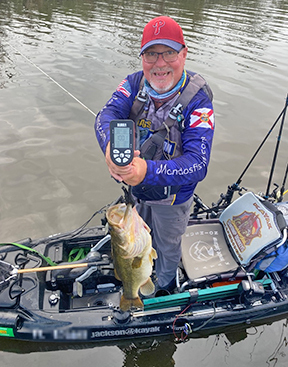
Kayaks
Kayaks have been around for centuries and are possibly the most versatile small craft on our list. Many of today’s offerings are tough but lightweight, and the most graceful and efficient man-powered watercraft you can get. For most pond and lake work (and even some Intracoastal and inshore fishing), a 10’ to 12’ model will work well. While preferences vary, most users will probably find a “sit-on-top” model easier to paddle (and get in and out of) than the “sit-in” style. Make sure you purchase a fishing-specific kayak that incorporates rod holders and tackle storage. Fishing kayaks are also usually wider and more stable than standard touring kayaks, an important feature. And if there’s one thing experienced kayakers agree on, it’s this: fork out the extra dollars for a lightweight paddle (such as the carbon fiber models)—your arms will thank you at the end of a long day. Self-propelled (pedal) models are also available, but sacrifice some storage space for the propeller mechanism and cost and weigh significantly more. Selecting a kayak is a more personal choice than for most other watercraft, and for this reason some shops offer free demo days so that a prospective buyer can find a model that is comfortable and feels right. Cost starts at about $300 to well over $1,000 for some self-propelled models, but the average kayak will run $400 to $500. Consider paying for an introductory paddling class along with your new purchase, as well. For a much more detailed look at kayaks and accessories, see the Florida Freshwater Angler Issue 29, Issue 30, and Issue 31.
Photo: Modern kayaks are state-of-the-art and can be loaded with personalized accessories, as can be seen on Gregory Thomas' tournament-winning boat.
Next issue we'll look at canoes and johnboats, and wrap up with some general small boat tips.
|
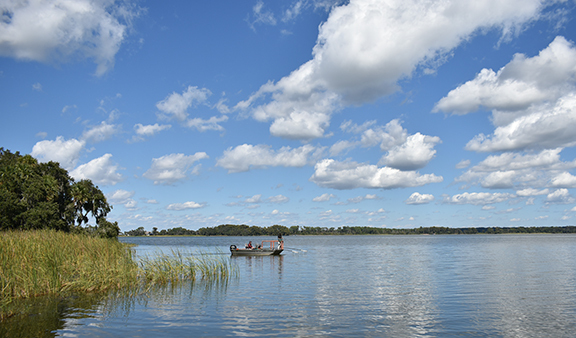 |
A FWC electrofishing boat helps monitor fish populations on Lakes Beauclair and Dora.
Size: 1,126 acres; 4,385 acres, respectively
Location: Lake County
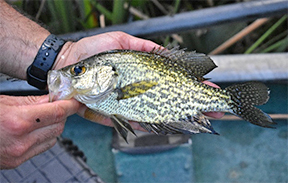
Description: Along the shorelines of the cities of Tavares and Mount Dora, sit the picturesque Lakes Beauclair and Dora. Similar to much of the Harris Chain of Lakes, Beauclair and Dora were historically high-nutrient systems with limited habitat and low volume of submersed aquatic vegetation (SAV). While supporting a limited largemouth bass fishery, this environment was capable of producing booming black crappie (speck) years, which many anglers capitalized on, as witnessed by high catch rates in past angler creel surveys. Over time, however, efforts to restore and revitalize the Harris Chain produced wide-ranging effects, leading to lake balance shifts in many of the lakes. In particular, renovations on Lake Apopka, including the restoration of the northshore marshes in the 1990’s, and construction of a nutrient reduction facility in the 2000s on the Apopka-Beauclair canal led to a dramatic decrease in nutrients and a significant increase in water clarity. This allowed aquatic plants to begin to take hold in both lakes throughout the 2010s. Over time, these plants consumed more nutrients, creating a cycle of clearer water and even more SAV. Higher levels of SAV enabled largemouth bass numbers to increase, and coupled with an abundance of forage and habitat, the bass fishery was revitalized. In recent years, angler creel surveys have indicated a remarkable shift in fishing effort from black crappie to largemouth bass. In fact, in 2023, bass fishing effort on Lakes Beauclair and Dora (39,943 hours) was more than that of Lake Griffin (27,751 hours), a state-renowned bass fishery almost twice the size of these two lakes. While crappie effort has waned in recent years, success rate for both bass and crappie anglers in 2023 was also the highest ever recorded, almost reaching Harris Chain historic records, revealing these lakes are still more than capable of providing a good day of fishing.
|
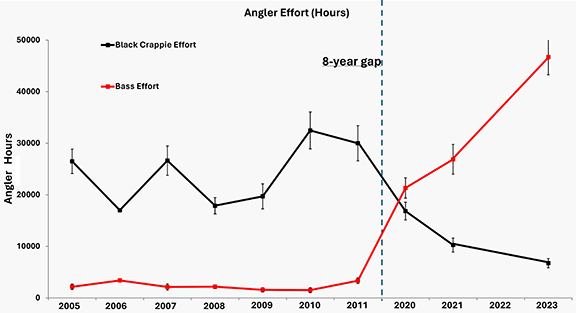 Although Lakes Beauclair and Dora offer good fishing for both bass and crappie (specks), creel surveys show that in recent years anglers have focused most of their effort on bass (red line).

Fishing for bass in Lake Beauclair has produced many tournament winners, whether dropping offshore in the submersed vegetation, or casting the shoreline for a lunker or two. Plant coverage was 91% of the entire lake area in summer of 2023, so there are plenty of areas to key in on. As for crappie fishing, SAV can make it hard to spider-rig, but some folks have luck jigging shallow water emergent vegetation while crappie are spawning inshore. Lake Dora has always been a great spot for large bass and should continue to provide ample opportunities. Submerged plant coverage is typically between 15-20%, providing good prospects for both bass and crappie anglers alike. All signs point to these two lakes remaining as major players in the Harris Chain fishery. (Angler is Richard Clark with an 8 lbs. 12 oz. Lake Dora TrophyCatch bass.)
|
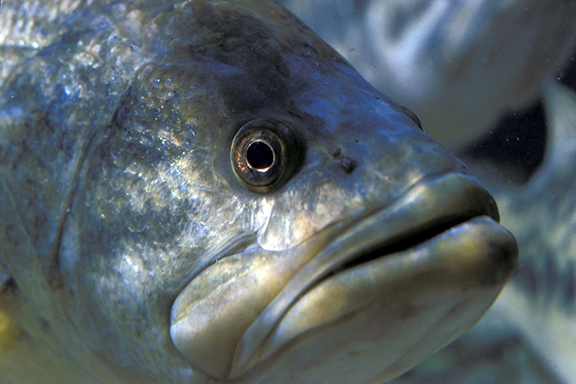 |
In the classic Edgar Allen Poe story “The Tell-Tale Heart,” a murderer feels compelled to confess his crime when he believes he can hear the tattletale beating heart of his victim revealing his wrongdoing to the police. In a less sinister way, fish have “tell-tale mouths” that reveal a lot about each fish species and how it lives to the observant detective!

The shape of a fish's mouth is mostly determined by what it eats. The largemouth bass (aka “bigmouth bass” or "bucketmouth") didn’t get its name for nothing. This ambush predator eats just about anything: other fish, snakes, frogs, crayfish, insects, turtles and even birds! In order to effectively capture a wide variety of fast-moving prey, this fish’s “bucketmouth” is a great help. A bass will literally inhale its prey into its cavernous mouth, then expel the excess water. Its gill rakers allow water to pass through, but make sure that dinner stays put. The bass is definitely one fish whose dental gear tells a lot about its lifestyle!
|

Gar and pickerel feed almost exclusively on fish. Their long, thin mouths present a streamlined frontal surface so that they can move forward quickly and efficiently to run down their agile prey. Once they bite, they have mouths loaded with teeth to keep hold of a wriggling fish. If bass are buckets, these fish are spears. If you have never seen a gar before, you’d still be able to guess pretty easily that its mouth is designed to hang onto something that’s usually pretty good at getting away.
|

Sunfish have tiny, dainty mouths that are a pretty good match to the tiny critters they eat. Although they also eat a variety of prey like bass do (insects, crustaceans, worms, fish), the difference is that they don’t eat nearly as wide a variety of foods, and their prey is much smaller. A bluegill, for example, has an ideal body shape for making short dashes to nab grass shrimp or dragonfly larvae out of dense vegetation, and it doesn’t need a bigger mouth for grabbing such tiny morsels. A redear sunfish’s mouth is similarly matched for such meals. The redear’s mouth also accommodates its habit of picking small clams and snails off the bottom, and in an even more advanced adaptation actually has hard crushing plates in the back of its mouth for breaking them open.
|
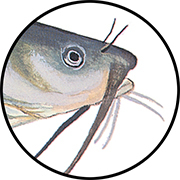
Catfish probably exhibit the greatest mouth specialization, not because they eat a narrow range of foods (they don’t), but because of how highly adapted they are for finding it. Catfish are scavengers that have taste- and touch-sensitive barbels around their mouths that help them to smell and locate any food in the immediate area. Commercial “stink baits” capitalize on this by having strong-smelling ingredients that attract catfish. Going one step further, sensory cells on catfish barbells practically allow them to taste their food outside of their mouths before they swallow it. The underside of a catfish’s mouth is flat, also allowing it to more easily feed along the bottom.
|
So the next time you see a fish, remember Edgar Allen Poe. And take a close look at that fish’s mouth—it might be telling you something!
Fish illustrations modified from Duane Raver, Jr. Bass photo by Glen Lau.
To contact the Florida Freshwater Angler, email John Cimbaro. Fish illustrations by Duane Raver, Jr. and Diane Rome Peebles.
|